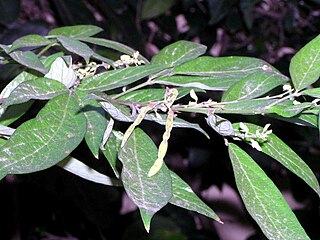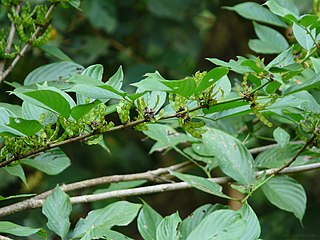
Pisum is a genus of the family Fabaceae, native to southwest Asia and northeast Africa. It contains one to five species, depending on taxonomic interpretation; the International Legume Database (ILDIS) accepts three species, one with two subspecies:

Senna spectabilis is a plant species of the legume family (Fabaceae) in the subfamily Caesalpinioideae native to South and Central America. They are often grown as an ornamental in front yards, parks, gardens, buildings etc. due to their bright yellow flowers that bloom during the summer months. They are also known as Golden wonder tree, American cassia, Popcorn tree, Cassia excelsa, Golden shower tree or Archibald's cassia.

Leucaena leucocephala is a small fast-growing mimosoid tree native to southern Mexico and northern Central America and is now naturalized throughout the tropics.

Senna tora is a dicot legume in the subfamily Caesalpinioideae. Its name is derived from its Sinhala name Tora (තෝර). It grows wild in most of the tropics and is considered a weed in many places. Its native range is in Central America. Its most common English name is Sickle Senna or Sickle Wild sensitive-plant. Other common names include sickle pod, tora, coffee pod, tovara, chakvad, thakara in Malayalam and foetid cassia. It is often confused with Chinese Senna or Sicklepod, Senna obtusifolia.

Vachellia aroma is a small, perennial, thorny tree native to Peru, Chile, Argentina and Paraguay. Some common names for it are aromita, aromo negro, espinillo and tusca. It is not listed as being a threatened species. Although some sources say that Vachellia macracantha is synonymous with Vachellia aroma, genetic analysis of the two species has shown that they are different, but that they are closely related.

Senegalia catechu is a deciduous, thorny tree which grows up to 15 m (50 ft) in height. The plant is called khair in Hindi, and kachu in Malay, hence the name was Latinized to "catechu" in Linnaean taxonomy, as the type-species from which the extracts cutch and catechu are derived. Common names for it include kher, catechu, cachou, cutchtree, black cutch, and black catechu.

Vachellia horrida is a low spreading shrub or sometimes tree native to both the wet and dry scrublands of tropical to subtropical East Africa. Common names for it are Cape Gum and Dev-Babul. It is also found elsewhere in Africa, Asia, India and South America. It frequently has stipular spines 9.5 cm long. V. horrida is an important browse plant in the tropics, particularly during the dry season.

Senegalia tenuifolia is a perennial climbing shrub which is native to Asia, the Caribbean, India and South America. Common names are Ara a Gato, Bejuco Cochino, Tocino. It is not listed as being a threatened species. Senegalia tenuifolia grows to 8 m high and 10–15 cm in diameter.
Chloroleucon chacoense, the palo barroso or palo overo, is a species of legume in the family Fabaceae. It is found in Argentina, Bolivia, and Paraguay. It is threatened by habitat loss.
Delonix baccal is a species of leguminous tree in the family Fabaceae. It is found in Ethiopia, Kenya, and Somalia.

Ohwia caudata, formerly placed in the genus Desmodium, is a deciduous nitrogen fixing plant in the family Fabaceae. It is found in India, China, Taiwan and other parts of Asia. The shrub grows to a height of about 1.5 m tall. It is related to Arthroclianthus, Nephrodesmus and Hanslia. The leaves and roots of the plant are used as an insecticide.
Abarema piresii is a species of legume of the genus Abarema in the family Fabaceae. The species can be found in the state of Pará in northern Brazil.
Stonesiella selaginoides is a species of flowering plants in the legume family, Fabaceae. It belongs to the subfamily Faboideae. It is the only member of the genus Stonesiella and is endemic to Tasmania. It is named to recognise Australian botanical illustrator, Margaret Stones.

Hultholia mimosoides is a liana species and the sole species in the genus Hultholia. It was formerly placed in the genus Caesalpinia but phylogenetic studies identified the group to be polyphyletic, leading the placement of Caesalpinia mimosoides in a new genus, Hultholia in the tribe Caesalpinieae. Its distribution includes: Bangladesh, Yunnan in China, India, Laos, Myanmar, Thailand, and Vietnam.

Albizia chinensis is a species of legume in the genus Albizia, native to south and southeast Asia, from India to China and Indonesia.

Dendrolobium triangulare is a species of flowering plants in the legume family, Fabaceae. It is found in Taiwan, China, Cambodia, India, Laos, Malaysia, Myanmar, Nepal, Sri Lanka, Thailand, Vietnam and few African countries. Leaves are trifoliate, where blade narrowly obovo-elliptic. Flowers white or pale yellow. Seed elliptic. Roots of the plant are widely used for medicinal purposes to strengthen bones and build muscle.
Mezoneuron sumatranum is a leguminous species first described by William Roxburgh. No subspecies are listed in the Catalogue of Life. This and a number of similar species are called "cat's claw" lianas: recognisable by raised spines on stems and found in tropical forests of the Indian subcontinent, Indochina, Malesia and Papua New Guinea.

Mezoneuron is a genus of flowering plants in the legume family, Fabaceae. It belongs to the sub family Caesalpinioideae and the tribe Caesalpinieae.
Mezoneuron andamanicum is a species of 'cat's claw' lianas, previously placed in the genus Caesalpinia, in the tribe Caesalpinieae. This species is recorded from the Andaman Islands, Indo-China and Malesia, with no subspecies.
Mezoneuron hymenocarpum is a species of 'cat's claw' lianas, previously placed in the genus Caesalpinia, in the tribe Caesalpinieae. Records are from: India, Indo-China, Malesia through to Australia, with no subspecies.












